Abstract
Heat-killed Pseudomonas aeruginosa inhibit antibody response in C57BL/6 mice. The depression of this response is dependent on the dose of bacteria injected, on the time interval between microorganism injection and antigen administration, and on the nature of the antigen used. Cell transfer experiments provide evidence that suppressor cells are not operative in this model. Furthermore, the results show that P. aeruginosa induces a marked dose-dependent proliferation of spleen cells in vivo, and the in vitro targets of this proliferative effect are B lymphocytes. It is suggested that whole, heat-killed P. aeruginosa in vivo also behave as cell mitogens on B lymphocytes which, when strongly stimulated to proliferate, temporarily lose their capacity to mount a normal antibody response.
Full text
PDF
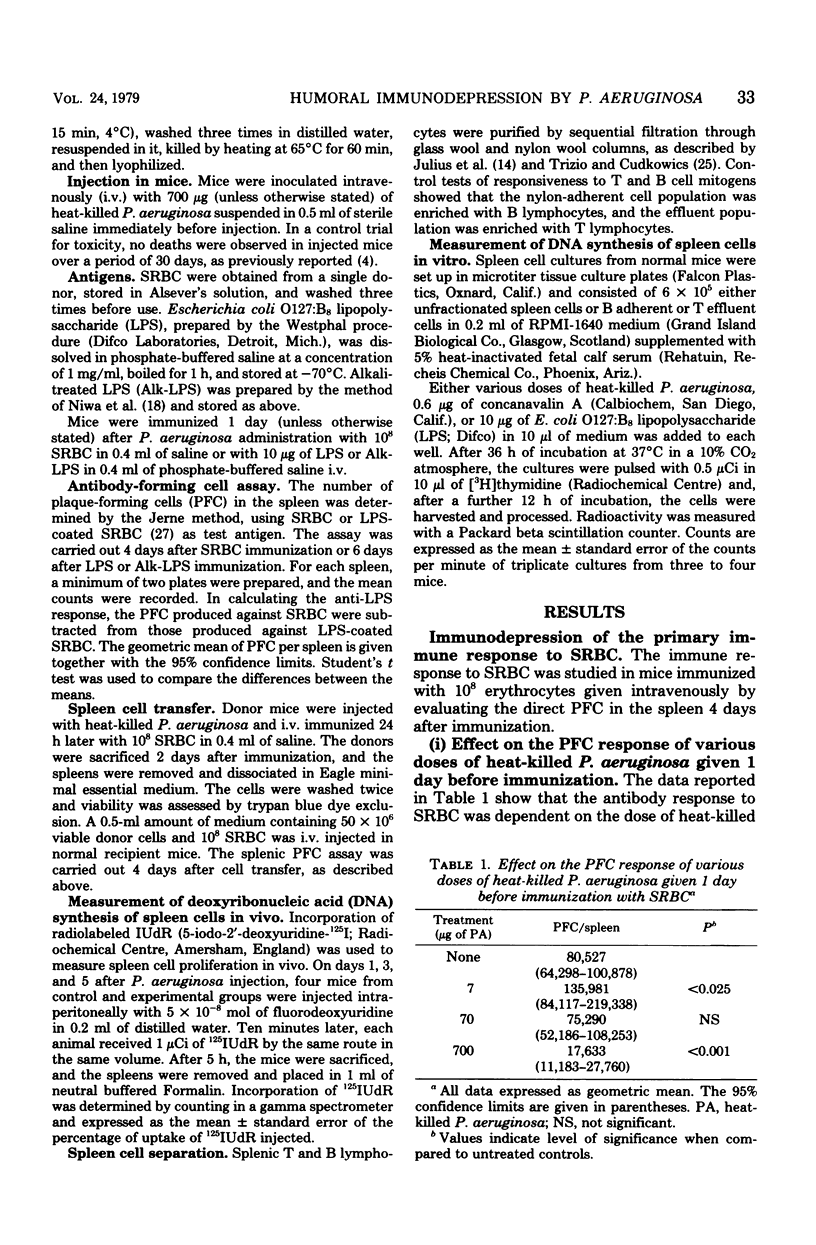
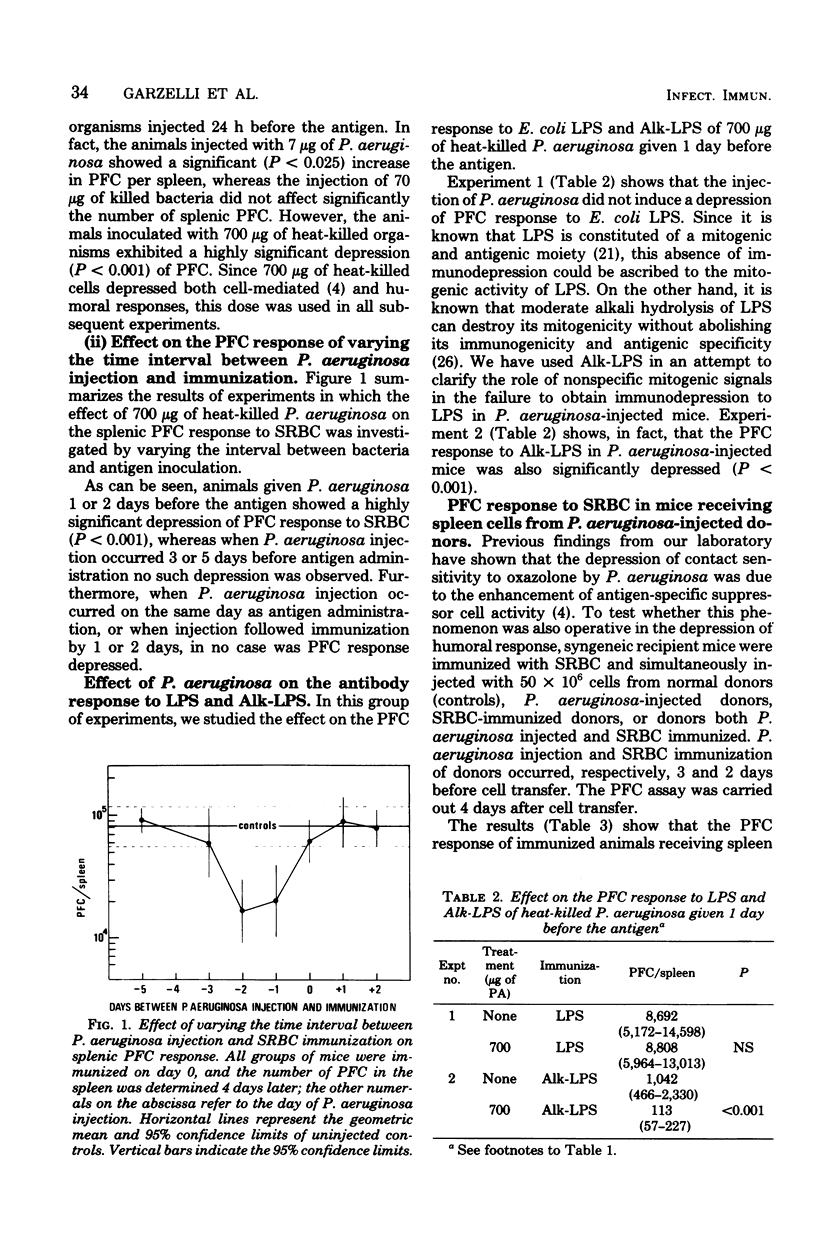

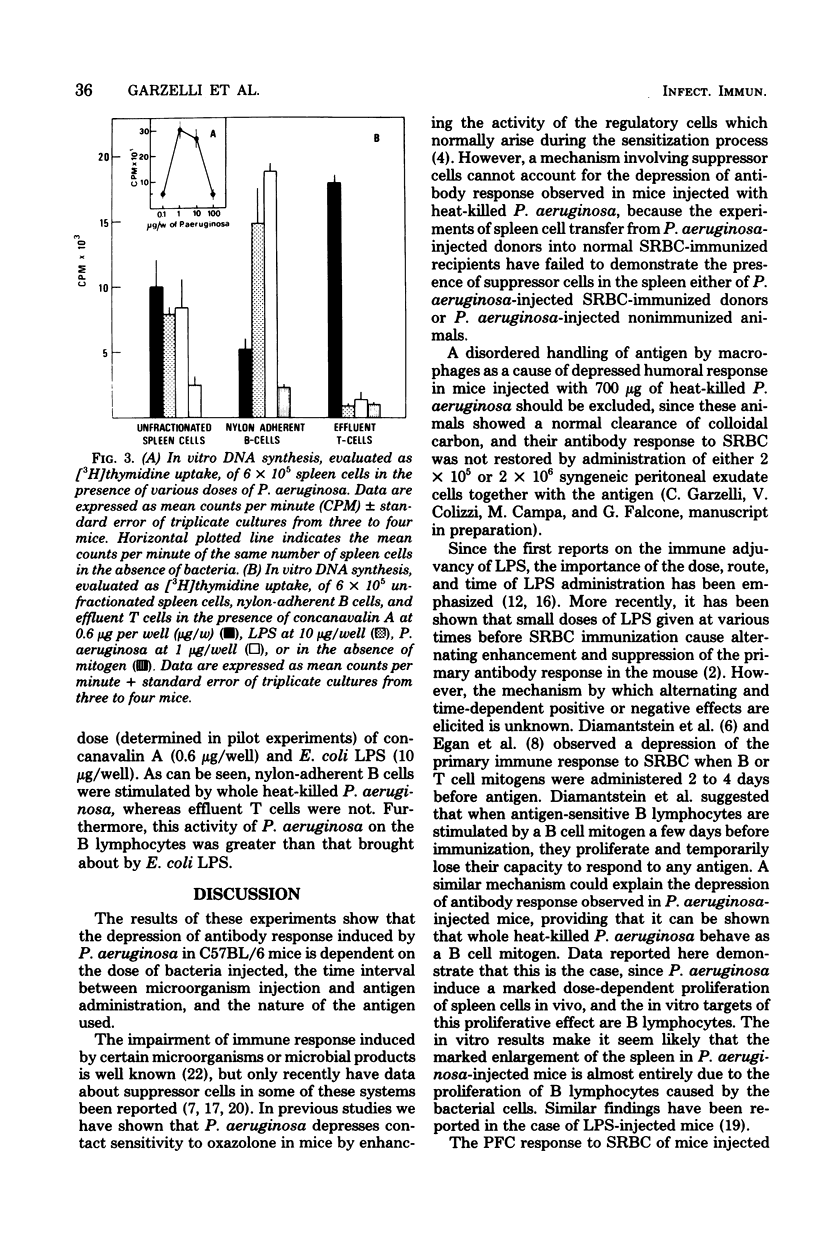
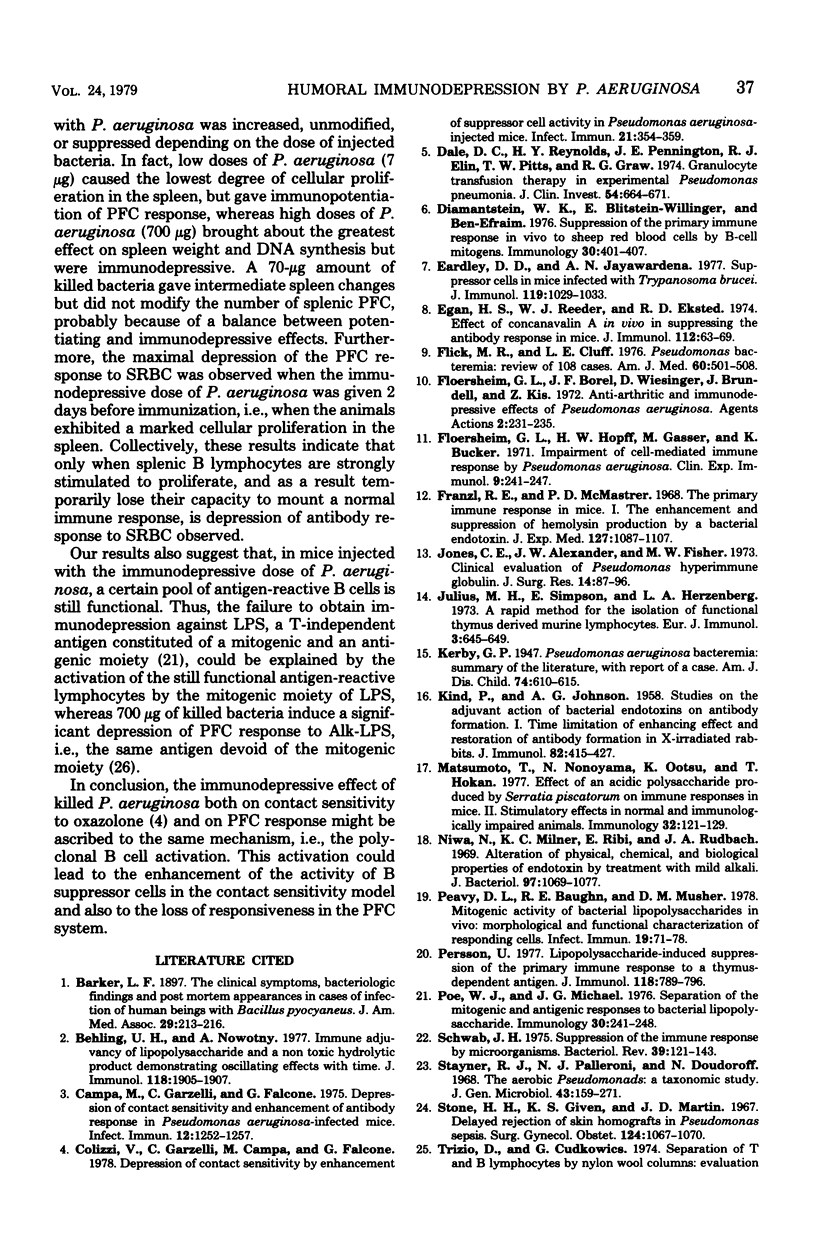
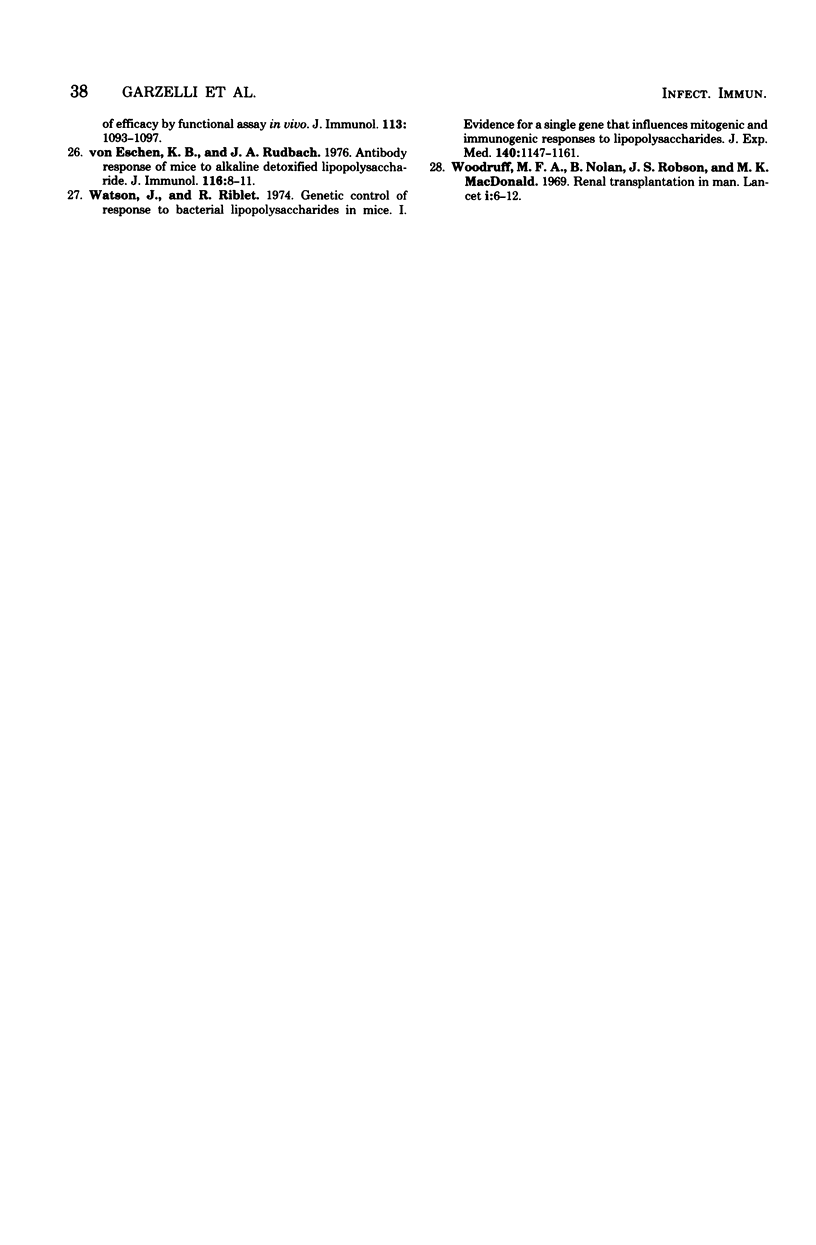
Selected References
These references are in PubMed. This may not be the complete list of references from this article.
- Behling U. H., Nowotny A. Immune adjuvancy of lipopolysaccharide and a nontoxic hydrolytic product demonstrating oscillating effects with time. J Immunol. 1977 May;118(5):1905–1907. [PubMed] [Google Scholar]
- Campa M., Garzelli C., Falcone G. Depression of contact sensitivity and enhancement of antibody response in Pseudomonas aeruginosa-infected mice. Infect Immun. 1975 Dec;12(6):1252–1257. doi: 10.1128/iai.12.6.1252-1257.1975. [DOI] [PMC free article] [PubMed] [Google Scholar]
- Colizzi V., Garzelli C., Campa M., Falcone G. Depression of contact sensitivity by enhancement of suppressor cell activity in Pseudomonas aeruginosa-injected mice. Infect Immun. 1978 Aug;21(2):354–359. doi: 10.1128/iai.21.2.354-359.1978. [DOI] [PMC free article] [PubMed] [Google Scholar]
- Dale D. C., Reynolds H. Y., Pennington J. E., Elin R. J., Pitts T. W., Graw R. G., Jr Granulocyte transfusion therapy of experimental Pseudomonas pneumonia. J Clin Invest. 1974 Sep;54(3):664–671. doi: 10.1172/JCI107804. [DOI] [PMC free article] [PubMed] [Google Scholar]
- Diamantstein T., Keppler W., Blitstein-Willinger E. Suppression of the primary immune response in vivo to sheep red blood cells by B-cell mitogens. Immunology. 1976 Mar;30(3):401–407. [PMC free article] [PubMed] [Google Scholar]
- Eardley D. D., Jayawardena A. N. Suppressor cells in mice infected with Trypanosoma brucei. J Immunol. 1977 Sep;119(3):1029–1033. [PubMed] [Google Scholar]
- Egan H. S., Reeder W. J., Ekstedt R. D. Effect of concanavalin A in vivo in suppressing the antibody response in mice. J Immunol. 1974 Jan;112(1):63–69. [PubMed] [Google Scholar]
- Flick M. R., Cluff L. E. Pseudomonas bacteremia. Review of 108 cases. Am J Med. 1976 Apr;60(4):501–508. doi: 10.1016/0002-9343(76)90716-6. [DOI] [PubMed] [Google Scholar]
- Floersheim G. L., Borel J. F., Wiesinger D., Brundell J., Kis Z. Antiarthritic and immunosuppressive effects of Pseudomonas aeruginosa. Agents Actions. 1972;2(5):231–235. doi: 10.1007/BF02087047. [DOI] [PubMed] [Google Scholar]
- Floersheim G. L., Hopff W. H., Gasser M., Bucher K. Impairment of cell-mediated immune responses by Pseudomonas aeruginosa. Clin Exp Immunol. 1971 Aug;9(2):241–247. [PMC free article] [PubMed] [Google Scholar]
- Franzl R. E., McMaster P. D. The primary immune response in mice. I. The enhancement and suppression of hemolysin production by a bacterial endotoxin. J Exp Med. 1968 Jun 1;127(6):1087–1107. doi: 10.1084/jem.127.6.1087. [DOI] [PMC free article] [PubMed] [Google Scholar]
- Jones C. E., Alexander J. W., Fisher M. Clinical evaluation of Pseudomonas hyperimmune globulin. J Surg Res. 1973 Feb;14(2):87–96. doi: 10.1016/0022-4804(73)90014-0. [DOI] [PubMed] [Google Scholar]
- Julius M. H., Simpson E., Herzenberg L. A. A rapid method for the isolation of functional thymus-derived murine lymphocytes. Eur J Immunol. 1973 Oct;3(10):645–649. doi: 10.1002/eji.1830031011. [DOI] [PubMed] [Google Scholar]
- KIND P., JOHNSON A. G. Studies on the adjuvant action of bacterial endotoxins on antibody formation. I. Time limitation of enhancing effect and restoration of antibody formation in x-irradiated rabbits. J Immunol. 1959 May;82(5):415–427. [PubMed] [Google Scholar]
- Matsumoto T., Nonoyama N., Ootsu K., Hokan T. Effect of an acidic polysaccharide produced by Serratia piscatorum on immune responses im mice II. Stimulatory effects in normal and immunologically impaired animals. Immunology. 1977 Feb;32(2):121–129. [PMC free article] [PubMed] [Google Scholar]
- Niwa M., Milner K. C., Ribi E., Rudbach J. A. Alteration of physical, chemical, and biological properties of endotoxin by treatment with mild alkali. J Bacteriol. 1969 Mar;97(3):1069–1077. doi: 10.1128/jb.97.3.1069-1077.1969. [DOI] [PMC free article] [PubMed] [Google Scholar]
- Peavy D. L., Baughn R. E., Musher D. M. Mitogenic activity of bacterial lipopolysaccharides in vivo: morphological and functinal characterization of responding cells. Infect Immun. 1978 Jan;19(1):71–78. doi: 10.1128/iai.19.1.71-78.1978. [DOI] [PMC free article] [PubMed] [Google Scholar]
- Persson U. Lipopolysaccharide-induced suppression of the primary immune response to a thymus-dependent antigen. J Immunol. 1977 Mar;118(3):789–796. [PubMed] [Google Scholar]
- Poe W. J., Michael J. G. Separation of the mitogenic and antigenic responses to bacterial lipopolysaccharide. Immunology. 1976 Feb;30(2):241–248. [PMC free article] [PubMed] [Google Scholar]
- Schwab J. H. Suppression of the immune response by microorganisms. Bacteriol Rev. 1975 Jun;39(2):121–143. doi: 10.1128/br.39.2.121-143.1975. [DOI] [PMC free article] [PubMed] [Google Scholar]
- Stanier R. Y., Palleroni N. J., Doudoroff M. The aerobic pseudomonads: a taxonomic study. J Gen Microbiol. 1966 May;43(2):159–271. doi: 10.1099/00221287-43-2-159. [DOI] [PubMed] [Google Scholar]
- Stone H. H., Given K. S., Martin J. D., Jr Delayed rejection of skin homografts in Pseudomonas sepsis. Surg Gynecol Obstet. 1967 May;124(5):1067–1070. [PubMed] [Google Scholar]
- Von Eschen K. B., Rudbach J. A. Antibody responses of mice to alkaline detoxifield lipopolysaccharide. J Immunol. 1976 Jan;116(1):8–11. [PubMed] [Google Scholar]
- Woodruff M. F., Nolan B., Robson J. S., MacDonald M. K. Renal transplantation in man. Experience in 35 cases. Lancet. 1969 Jan 4;1(7584):6–12. doi: 10.1016/s0140-6736(69)90982-9. [DOI] [PubMed] [Google Scholar]


